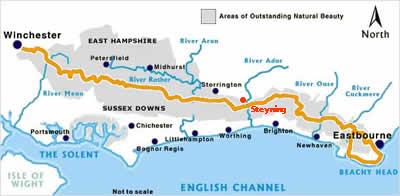There have been people walking the hill-top trails of the South Downs for over six thousand years. From the late Stone Age (Neolithic) onwards, travellers have recognised the same rolling downland horizons with glittering glimpses of the sea. Walkers can still share something of this ancient experience. Although the signs of modern life are never far away, there has always been the birdsong, the butterflies and the fragrance of grass pollens on the breeze. Like Neolithic people, we can also feel the flinty chalk beneath our feet.

The dramatic chalk ridge of the South Downs stretches from Eastbourne to Winchester. In 1972 the Countryside Commission designated the South Downs Way as the first long distance bridleway in the country. This waymarked national trail is over 100 miles long and has become a feature of the South Downs National Park. It is a great route for horse-riding and cycling as there are few gates.
The South Downs Way comes into the east of the Steyning area down Beeding Hill. This is the infamous incline of the old coaching route which turned off to take exhausted horses and passengers to Beeding and Bramber or beyond. The South Downs Way crosses the A283 road to the Adur River bank. A modern footbridge carries the path across the river and past Saint Botolph’s Church. This was founded in Saxon times. Later Norman charters refer to this church as Saint Peter at “Veteri Ponte” or the old bridge. An ancient causway, ferry or bridge may have spanned the Adur at this point to take travellers across the river from Beeding Hill. Along the narrow Coombes Road the route passes Annington, which is mentioned in Anglo-Saxon charters, and turns off to make its way towards Chanctonbury Ring, with views of the stately Wiston House.The distinctive beech trees on top of the Ring are a famous local landmark. A Bronze Age enclosure and the remains of a Roman shrine have been found on the hill-top at Chanctonbury.
Listen to Clare Balding’s BBC Radio Four “Ramblings”, Series 15, as she walks the South Downs Way
